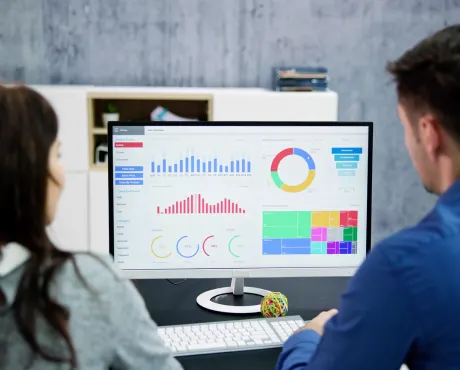Table of Contents
For manufacturers, managing raw materials efficiently is a critical challenge that impacts every aspect of the production process. From preventing costly delays to controlling waste and maintaining quality, the way raw materials are tracked can determine the overall success of a manufacturing operation. Traditional manual methods, such as spreadsheets and paper records, have proven error-prone and inefficient as supply chains grow more complex. The solution? Raw material tracking software- a modern digital solution that gives real-time visibility, control, and optimization of your material resources.
In this blog, we will explore how raw material tracking software can transform your manufacturing process, detailing its core features, benefits, and operational impacts.
By integrating real-time financial information into operational workflows, businesses can monitor performance metrics continuously, respond to variances immediately, and optimize processes proactively. In this blog, we explore what real-time financial data means, how it directly impacts operational control, and how organizations can apply it for better outcomes across departments.
Understanding Raw Material Tracking Software

Raw material tracking software is a dedicated digital tool built to oversee the movement and stock levels of raw materials across every stage of the manufacturing process. It captures detailed information on what materials are received, stored, consumed, and replenished at every stage.
Key features often include:
- Inventory Management: Real-time tracking of stock levels and locations to ensure materials are available when needed.
- Batch and Lot Tracking: Recording batch or lot numbers, production dates, and expiration information to ensure traceability and quality control.
- Integration with Scanning Technologies: Use of barcodes, QR codes, or RFID tags to automate data capture and reduce manual errors.
- Automated Alerts and Notifications: Proactive alerts on low stock levels, expiration dates, or supply delays enable timely decision-making.
- Comprehensive Audit Trails: Documentation of every transaction related to material movement, offering accountability and simplifying audits.
These features of material management software help manufacturers replace outdated manual practices with a streamlined, automated system that improves accuracy and responsiveness.
Core Benefits of Material Tracking Software

a) Improved Inventory Management and Stock Accuracy
A key advantage of inventory management software is its capability to deliver precise, up-to-the-minute visibility into inventory status. This eliminates guesswork and reduces risks of both stockouts, which can halt production, and overstocking, which ties up valuable capital and space. With constantly updated data, manufacturers can make fast, intelligent purchasing decisions and maintain optimal inventory levels that support smooth production workflows.
b) Enhanced Production Efficiency
By digitizing inventory tracking, manufacturers can significantly improve production workflows. Eliminating the time wasted searching for materials or addressing inventory mistakes accelerates manufacturing cycles. Automated data capture and alerts help quickly detect shortages or quality issues, allowing for immediate corrective action and minimizing downtime.
c) Better Cost Control and Reduced Waste
Monitoring material usage at a granular level helps identify inefficiencies and avoid excess purchasing. Features like FIFO (First In, First Out) and expiration tracking ensure materials are used optimally, reducing spoilage or obsolescence. These improvements lower overall material costs and increase profitability.
d) Improved Quality Control and Compliance
Batch and lot tracking features enable manufacturers to trace every raw material back to its source. This traceability supports fast recalls if defects appear and helps maintain compliance with industry regulations. Detailed records also provide data needed during audits and certifications, strengthening product quality management.
e) Powerful Reporting and Analytics
Predictive analytics and reporting features in a raw material inventory management software reveal patterns in material usage, evaluate supplier reliability, and assess operational productivity. This data empowers manufacturers to forecast demand more accurately, plan production schedules effectively, and pursue continuous operational improvements.
f) Enhanced Customer Satisfaction
Reliable access to materials and consistent production schedules translate into on-time delivery of finished products. This reliability builds trust with customers, fosters positive relationships, and supports business growth.
How Raw Material Tracking Increases Operational Efficiency
The best raw material tracking software contributes directly to operational efficiency in several distinct ways:

Real-Time Inventory Visibility
Continuous access to up-to-date information about raw material quantities and locations enables proactive decision-making. With these insights, manufacturers can foresee potential shortages or excess stock and proactively adapt their purchasing and production schedules.
Streamlined Production Processes
By reducing the time workers spend locating materials or handling errors, production flows more smoothly. Automated tracking minimizes bottlenecks and accelerates throughput.
Reduced Waste and Operational Costs
Accurate tracking prevents over-ordering and resource misallocation. It also helps identify and eliminate waste caused by spoilage, expired stock, or theft.
Improved Forecasting and Demand Planning
Data on actual material usage allows for better predictions of future raw material requirements, leading to more efficient purchasing and inventory management.
Faster Error Detection and Troubleshooting
Audit trails and traceability features help detect discrepancies immediately and facilitate quick resolutions, ensuring consistent operations.
Better Supplier Coordination
Tracking systems improve communication and coordination with suppliers, enabling just-in-time inventory models that reduce lead times and excess inventory.
Regulatory Compliance and Quality Control
In regulated industries, tracking ensures adherence to strict quality and safety standards through complete material traceability.
Together, these advantages create a lean manufacturing setup that responds swiftly and effectively to shifting demands and emerging challenges.
Also Read: Why Traditional Costing Is Manufacturing’s Most Dangerous Blind Spot
Who Can Use Raw Material Tracking Software
Everyone who manufactures. The tracking software has common features needed in different types of manufacturing industries, such as:

- Food and Beverage: Tracking perishable ingredients is vital to meet food safety standards and avoid spoilage. Traceability supports recalls and consumer trust.
- Pharmaceuticals: Regulatory compliance requires detailed batch tracking to ensure drug safety and facilitate audits.
- Automotive: Managing complex assemblies with many sourced components requires precise inventory management to keep production lines running smoothly.
- Consumer Goods: Fast-moving goods benefit from tracking to maintain a continuous supply and meet customer expectations.
Numerous manufacturers have successfully improved efficiency, reduced costs, and enhanced quality by implementing raw material tracking solutions, proving their value as a strategic investment.
How to Choose the Right Raw Material Tracking Software
Choosing the right raw material monitoring system involves evaluating several factors:
- Industry Alignment and Growth Potential: Choose a platform tailored or easily adaptable to your industry’s needs and scalable to support future business expansion.
- Integration with Existing Processes: Ensure the software can connect with your ERP, accounting, and production systems to avoid operational silos.
- User-Friendliness and Support: The system should be easy to use for your team and backed by reliable vendor support for smooth implementation and maintenance.
A Few Steps to Get Started
Implementing raw material tracking software requires a structured approach:
- Assess Current Challenges and Needs: Identify pain points in your existing raw material management and define goals for the new system.
- Select and Customize the Right Solution: Choose software that fits your needs and configure it for your processes.
- Train Staff and Set Up Best Practices: Provide comprehensive training and develop standardized procedures to maximize software effectiveness.
- Monitor Performance and Continuously Improve: Use the system’s reporting tools to track KPIs and refine operations over time.
Following these steps helps ensure a successful transition and rapid return on investment.
Conclusion
For manufacturers aiming to thrive in today’s demanding market, raw material tracking software provides a crucial competitive edge. It offers instant visibility into inventory, boosts production efficiency, minimizes waste, upholds quality standards, and aids in informed strategic decisions. By adopting this transformative technology, manufacturers can achieve operational excellence, cost savings, and improved customer satisfaction.
If you’re exploring ways to optimize your manufacturing process, investing in raw material tracking software is a smart and necessary step towards future-ready, efficient production.





